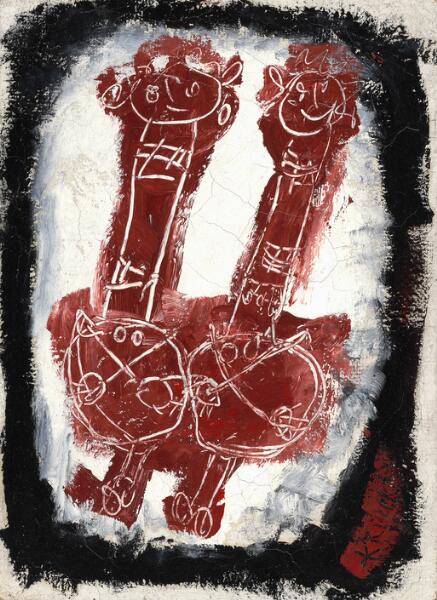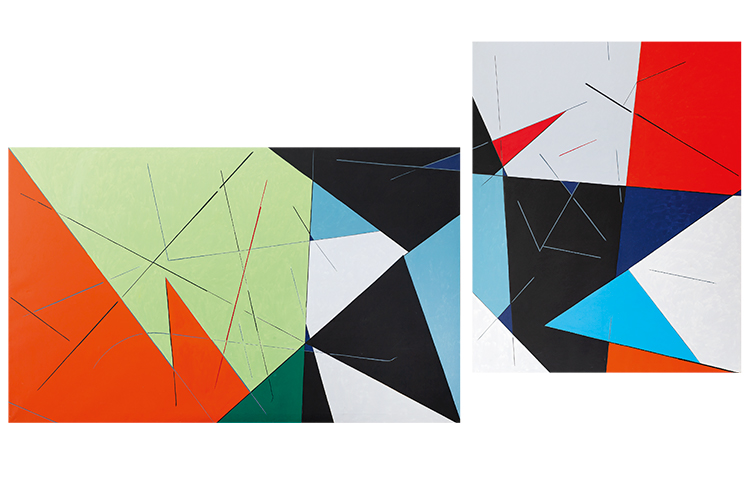Concrete Art by Richard Mortensen
Richard Mortensen's 1978 two-part work La Résistance stands as the epitome of the Concrete idiom of abstract art that Mortensen introduced in Denmark back in the 1960s and expressed in his artistic work.
At this autumn's Live Auction of Modern Art, Richard Mortensen's (1910-93) diptych La Résistance is hard to overlook. The format is enormous – two interconnected works of 195 x 320 cm and 240 x 195 cm respectively, and the surfaces of the paintings contain the geometric shapes and zigzag patterns in strong colours that are so characteristic of the Danish artist. The work is a sublime example of Mortensen's more than 60 years of work as an artist, where the Concrete idiom became a consistent guideline from the late 1940s and until his death.
Inspiration from the Parisian Art Scene
In 1947, Mortensen travelled with his friend Robert Jacobsen to Paris and joined the circle of artists around Galerie Denise René, which included names such as J. Dewasne, J. Deyrolle, S. Poliakoff and V. Vasarely. The common denominator of this international art scene was a simplified and abstract idiom. 17 years later, Mortensen returned home with these avant-garde inspirations in his luggage and became Denmark's leading Concrete artist with his highly simplified, geometric compositions. He has been called “Stramhedens mester” (The Master of Tightness), and he has contributed more than most to the development of abstract painting in Denmark. The international breakthrough came during the early 1950s, where he had several solo exhibitions around the world, and today his art is on display at international museums such as the Museo Español de Arte Contemporaneo in Madrid, the Musée Nationale d'Art Moderne in Paris and Nationalmuseet in Stockholm.
An Art Form with Room for Debate
Mortensen's Concrete Art engages the viewer and activates the senses by virtue of the colours and geometric figures. Although the art movement as a starting point sought a purified, autonomous idiom without references to the surrounding reality, the ‘meaningless’ aesthetic was a utopia for Mortensen. Intellectually, there was a good deal of room for debate with him, and his art never closed itself off from the outside world. He often used literary and philosophical texts as sources or included his thoughts on Taoism, Zen Buddhism and Nordic mythology in his abstract paintings.
"Regardless of whether Mortensen works as an expressionist in his early art of the 30s and 40s or his talent and clear intellect later dictates a seemingly cooler method of painting and logically constructive composition, he remains one of the greatest painters of the century. Now, that we have put some distance between ourselves and the 1950s, it can be seen more clearly how he outmatched and surpassed most of his Parisian contemporaries.”
Knud W. Jensen, Founder of Louisiana - Museum of Modern Art.
Come and Hear More About Concrete Art!
The auction preview opens on Thursday 12 September at 3pm in Bredgade 33 with the presentation "Concrete Art – Then and Now" by Mette Højsgaard, Postdoc at the Department of Arts and Cultural Studies at the University of Copenhagen. Everyone is welcome.

For further information, please contact:
Niels Raben: +45 8818 1181 · nr@bruun-rasmussen.dk
Peter Beck (Aarhus): +45 8818 1186 · pb@bruun-rasmussen.dk
Niels Boe Hauggaard: +45 8818 1182 · nbh@bruun-rasmussen.dk
Annemette Müller Fokdal: +45 8818 1196 · amf@bruun-rasmussen.dk
Kathrine Eriksen: +45 8818 1184 · ke@bruun-rasmussen.dk
Victor Svane Nielsen: +45 8818 1125 · vsn@bruun-rasmussen.dk
Stephanie Ingemann-Petersen: +45 8818 1185 · sip@bruun-rasmussen.dk
